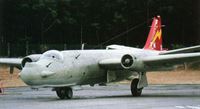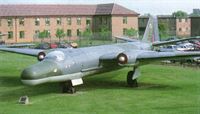Фотографии
-
Major modification work on Canberras continued at EE/BAC's Samlesbury facility until 1985, some 36 years after the first Canberra left the factory. This T.17, photographed in the workshops in December 1984, was originally built as a B.2.
Самолёты на фотографии: English Electric / BAE Canberra - Великобритания - 1949
-
Регистрационный номер: WJ680, G-BURM High-conspicuity yellow and black markings were applied to the undersides of 100 Squadron Canberra TT.18 as an aid to visual acquisition by the aircraft and surface gunners who fired at its towed targets. Note the underwing pylons on WJ680/'CT', used to carry Rushton towed targets.
Самолёты на фотографии: English Electric / BAE Canberra - Великобритания - 1949
-
A Canberra PR.7 of 58 Squadron, flown bya 13 Squadron crew, had the dubious distinction of being the RAF's only operational Canberra loss when it was shot down over Syria during the Suez campaign in November 1956. Initially equipped with cameras for medium and high-level survey and surveillance work, there was an increased interest in low-level tactical reconnaissance in the early 1960s, and the PR.7s of 13 Squadron were fitted with an F95 low-level optical camera and F97 night camera system.
Самолёты на фотографии: English Electric / BAE Canberra - Великобритания - 1949
-
Регистрационный номер: WD955 No.360 Squadron's Canberra T.17s were tasked with electronic warfare training, hence the appropriate lightning flash on the fin and either side of the fuselage roundel of T.17A, WD955/'EM', shortly before the squadron disbanded in October 1994. The distinctive 'wart' nose housed a variety of electronic countermeasures, as did the bomb bay.
Самолёты на фотографии: English Electric / BAE Canberra - Великобритания - 1949
-
Регистрационный номер: WT305 Possibly one of the most hazardous roles performed by the Canberra was that of intelligence gathering during the Cold War. Operated by 51 Squadron, Canberra B.6(Mod) WT305 flew covert missions for a short period in the 1970s over the Baltic and Mediterranean, under the code-name Project Zabra. These involved 'teasing' Soviet interceptors airborne and recording their infra-red signatures. WT305 was photographed (minus its infra-red sensor) when it was used a gate guardian at RAF Wyton.
Самолёты на фотографии: English Electric / BAE Canberra - Великобритания - 1949
-
Регистрационный номер: WJ879 With two crew sitting side-by-side in a cockpit originally designed for one, there was not a lot of 'elbow room' in the T.4, as may be appreciated from this wide-angle photograph of 231 OCU's WJ879. Acute lack of space also meant that the Martin-Baker Mk.3CT seats were almost upright, resulting in a most uncomfortable sitting posture.
Самолёты на фотографии: English Electric / BAE Canberra - Великобритания - 1949
-
Main Canberra variants
Самолёты на фотографии: English Electric / BAE Canberra - Великобритания - 1949English Electric / BAE Canberra B(I).8 / PR.9 - Великобритания - 1954
-
Регистрационный номер: XH134 [2] Considering that the Canberra was designed originally as a bomber, it is an extremely agile aircraft, as this view of PR.9 XH134 shows. All the Canberra PR.9’s latter operational sorties were flown alone, so it was deemed prudent to equip it with additional ECM equipment for self-protection. This included radar warning receivers on the wingtips and chaff/flare dispensers under the wing.
Самолёты на фотографии: English Electric / BAE Canberra B(I).8 / PR.9 - Великобритания - 1954
-
Регистрационный номер: XH134 [2], XH135 End of an era: two 39 (1 PRU) Squadron Canberra PR.9s, XH134 and XH135, formate over their home base of RAF Marham shortly before the unit was disbanded. Note the different colour schemes: XH135 (nearest) is finished in hemp, whilst XH134 has an Alkali Removable Temporary Finish applied for operations over Afghanistan.
Самолёты на фотографии: English Electric / BAE Canberra B(I).8 / PR.9 - Великобритания - 1954
-
Control of the reconnaissance sensors in the PR.9 was vested in the navigator, housed in the aircraft's nose. Access to the navigator’s compartment was via the hinged nose seen here. Of particular note are the stowed chart table, above which is the periscope viewfinder (truncated orange cone), and below and to the left of this is the control panel, used to input target data and control the cameras. Unlike the U-2, which carried the SYERS, in the PR.9 the system could be reprogrammed inflight.
Самолёты на фотографии: English Electric / BAE Canberra B(I).8 / PR.9 - Великобритания - 1954
-
Among the questions often asked about the PR.9 is why its cockpit was offset. In fact, the pilot's seat is in exactly the same lateral position as in the other models, hence the empty space to his right, which would have been occupied by the second seat in the trainer variant and the access door in the bombers. The fighter-style canopy gave excellent all-round vision - a boon in staying aware of both surface and airborne threats, and occasionally for aiming the cameras by eye.
Самолёты на фотографии: English Electric / BAE Canberra B(I).8 / PR.9 - Великобритания - 1954
-
EE/BAC Canberra B(I).8
Самолёты на фотографии: English Electric / BAE Canberra B(I).8 / PR.9 - Великобритания - 1954
Статьи
- News: Headline, Military, Civil, Airshow
- A.Brookes - Air War Over Lebanon /Military/
- B.Hales-Dutton - United At Manchester /Commercial/
- D.Willis - McDonnell Douglas DC-10 /Aircraft profile/
- J.Lake - EE Canberra in RAF Service /Military/ (2)
- L.Peacock - B-2 Spirit. Northrop Grumman's Silver Bullet /Military/
- M.English - Gulf Air. The Golden Falcon /Commercial/
- R.Burgess - US Naval aviation 2006 /Military/ (3)
- S.Wilson - Fincastle '06 ASW Competition /Military/











